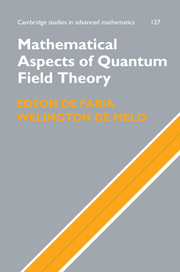Book contents
- Frontmatter
- Contents
- Foreword
- Preface
- 1 Classical mechanics
- 2 Quantum mechanics
- 3 Relativity, the Lorentz group, and Dirac's equation
- 4 Fiber bundles, connections, and representations
- 5 Classical field theory
- 6 Quantization of classical fields
- 7 Perturbative quantum field theory
- 8 Renormalization
- 9 The Standard Model
- Appendix A Hilbert spaces and operators
- Appendix B C* algebras and spectral theory
- Bibliography
- Index
3 - Relativity, the Lorentz group, and Dirac's equation
Published online by Cambridge University Press: 05 March 2013
- Frontmatter
- Contents
- Foreword
- Preface
- 1 Classical mechanics
- 2 Quantum mechanics
- 3 Relativity, the Lorentz group, and Dirac's equation
- 4 Fiber bundles, connections, and representations
- 5 Classical field theory
- 6 Quantization of classical fields
- 7 Perturbative quantum field theory
- 8 Renormalization
- 9 The Standard Model
- Appendix A Hilbert spaces and operators
- Appendix B C* algebras and spectral theory
- Bibliography
- Index
Summary
In this chapter, our goal is to show how quantum mechanics had to be modified to make it into a relativistic theory. The theory developed in Chapter 2 is not compatible with Einstein's special relativity: Schrödinger's equation is not relativistically invariant. The attempt by Dirac to make both theories compatible – Dirac's equation – showed that one had to abandon the idea of a physical system having a fixed number of particles. Dirac's theory allows creation and destruction of particles, forcing one to take up instead, as fundamental, the idea of quantum fields, of which particles become physical manifestations (eigenstates). This was the birth of quantum field theory.
Relativity and the Lorentz group
At the end of the nineteenth century, the Michelson–Morley experiments showing that light travels at a speed that is independent of the motion of the observer relative to its source, plus the discovery by Lorentz that the Maxwell equations are invariant under a large group of transformations, exposed a contradiction between Newtonian mechanics and Maxwellian electromagnetism. This led Einstein to reformulate the laws of mechanics (keeping the notion of inertial reference frame and Newton's first law; cf. Chapter 1).
Postulates
In essence, the basic postulates of Einstein's special relativity theory are the following.
(i) Principle of relativity: The laws of physics are the same in all inertial frames.
(ii) Invariance of uniform motion: If a particle has constant velocity in a given inertial frame, then its velocity is constant in every inertial frame.
(iii) Invariance of the speed of light: The speed of light is invariant across all inertial frames.
- Type
- Chapter
- Information
- Mathematical Aspects of Quantum Field Theory , pp. 51 - 64Publisher: Cambridge University PressPrint publication year: 2010

